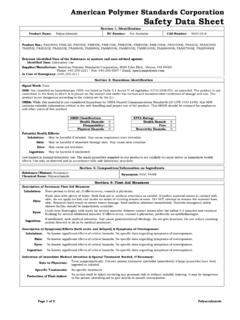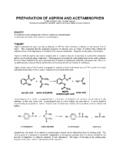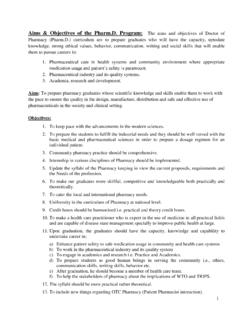Transcription of A Question of Molecular Weight - American …
1 A Question of Molecular Weight Dr. Jack Cazes International Division Waters Associates, Inc. 34 Maple St., Milford, MA 01757 The Molecular Weight of benzene is 78. What is the Molecular Weight of a given sample of polymer, for example, of polystyrene? A polymer does not have a single Molecular Weight ; we generally refer to a variety of Molecular Weight averages for a polymer, , Weight -average (Mw), number-average (Mn), and others. Before we deal with polymers, let's ask ourselves, what is a Molecular Weight ? What is the number that we refer to as Molecular Weight ? Molecular Weight , by the strict definition, is actually the Weight , in grams, of Avogadro's number of molecules of a substance , the Weight of approximately 6 X 10^23 molecules. So, for instance, if we are talking about a substance like benzene, we can simply think of benzene as consisting of an assemblage of many of the same kind of molecules, all of them having the same size and Weight .
2 To obtain the " Molecular Weight " of benzene we simply add up the atomic weights of all of the atoms in the molecule. Since benzene contains six carbons we take six carbons and multiply by the atomic Weight of carbon, 12, and obtain 72. We then take the six hydrogen's that are present in benzene and multiply by the atomic Weight of hydrogen, 1 and obtain 6. The sum, 72 + 6, is then the Molecular Weight of benzene, 78. This is straight forward. But now let's extend the a little further. Let's ask ourselves what is the Molecular Weight of polystyrene once again, or of any polymer. Here we run into a problem because, if we had the ability to look at the molecules in a sample of polystyrene, we would find that we have a mixture of many different size molecules. And there is where the problem lies! How do you obtain the Molecular Weight of a mixture of materials that are all different form each other in terms of their sizes and weights? All polymers, with only a few exceptions, are mixtures of molecules having different Molecular sizes and Molecular weights and therein lies our problem.
3 For a polymer, we use a " Molecular Weight average". We simply look at all of the different sizes of molecules and average them. The kind of Molecular Weight average we obtain depends upon the type of measurement used. And, this leads us to the number-average Molecular Weight , Weight -average Molecular Weight , Z-average Molecular Weight , viscosity-average Molecular Weight , and others. Analogy: STRAIGHT Average vs. WEIGHTED Average CREDITS GRADES Math 5 80 English 5 80 French 5 80 Art 2 80 Music 2 80 Phys. Ed. 1 80 20 STRAIGHT Average: (80 + 80 + 80 + 80 + 80 + 80) 6 = 80 WEIGHTED Average: (5 x 80) + (5 x 80) + (5 x 80) + (2 x 80)+ (2 x 80) + (1 x 80) 20 = 80 Before we get into a discussion of how to calculate a Molecular Weight average for a polymer, let's take a look at an analogy, something I am sure you are familiar with. Think back to when you were in school. Suppose you were taking a program of courses such as Math, English, French, Art, Music, and Physical Education.
4 Courses were worth different numbers of credits, depending on the relative difficulty of each course and upon the importance of the course in the curriculum. For example, let's assume that Math, English and French were worth 5 credits each, Art and Music, 2 credits each, and Physical Education only 1 credit, a total program of 20 credits. And let's assume that you were an "average" student; all of your grades were 80. To calculate a straight average, you simply add all of the grades for all the courses and then you divide by the total number of courses. This gives you an average of 80. Note that the average is identical to the grades when all of the grades are identical. In some schools, a different kind of "weighted" average is calculated; they recognize the fact that some courses are more difficult than others, some require more work and, thus, are more important. The grade for each course is multiplied by its corresponding number of credits, all of the products are added together, and the result is divided, not the number of courses, but by the total number of credits, In the case of the above example the result is again 80.
5 Credits Grades Grades Math 5 100 80 English 5 100 80 French 5 100 80 Art 2 80 100 Music 2 80 100 Phys. Ed. 1 80 100 20 STRAIGHT Average WEIGHTED Average 90 90 95 80 If the grades for the courses were different from each other, then the weighted average and straight average would not be the same. Let's see what happens to the averages if we change some of the course grades. Let's assume that you are a fairly good student in Math, English, and French so that, instead of 80, you received grades of 100 in those three courses. Now, if we calculate a straight average we obtain not 80, but 90. However, the weighted average now becomes 95. Suppose you are not very good at Math, English, and French, but, rather, are outstanding in Art, Music and Physical Education. Let's give you a 100 in those three courses; note that the 100 in this case is given to the courses that are worth fewer credits, , the "less important" courses. If we go through this exercise again the straight average is again 90.
6 Note that in both cases we end up with the same straight average, the reasons being that when we calculate a straight average, all courses are given equivalent importance. But, when we calculate a weighted average, since we have the high, , 100%, grades in the courses that do not carry as much credit, that are not as important, the result is a much lower weighted average than in the first case we discussed. In this case, the weighted average is only 85%. Note too, that in the original example, where all the grades were 80, the straight average and the weighted average were identical. Now, keeping in mind what we have just discussed concerning a "straight" or "number" average vs. a "weighted" average, let's get back to molecules, Molecular Weight , and polymers. There are several reasons why there are different kinds of Molecular Weight averages for polymers. One of these reasons is that we end up with different kinds of Molecular Weight averages depending on the way in which we obtain the data, , depending upon the type of physical or chemical measurement that is used to arrive at the Molecular Weight average.
7 Let's take a look at some examples. If we measure colligative properties of substances or the relative concentrations of end-groups in polymers then we obtain a Molecular Weight average in which all molecules are treated equally, , are of equivalent importance. What do we mean by colligative properties ? Certain properties of solutions are dependent only upon the numbers of Molecular or ionic species present in the solution, and not upon their weights or sizes. These are called colligative properties , and include boiling point elevation, freezing point depression, vapor pressure depression, and osmotic pressure changes. All of these are used to measure Molecular weights of substances, including polymers. End-group analysis, eg., hydroxyl number, carboxyl equivalent, etc., also lead to the Molecular Weight of a substance. The resultant Molecular Weight is analogous to the "straight" average discussed above, and is called the number-average Molecular Weight .
8 colligative properties End-Group Concentration * Osmotic Pressure * Hydroxyl Number * Boiling Point Elevation * Carboxyl Equivalent * Freezing Point Depression * Epoxy Equivalent, etc. * Vapor Pressure Mn THEY COUNT THE NUMBER OF MOLECULES OR EQUIVALENTS PER UNIT Weight OF SAMPLE All of these Molecular Weight methods count the numbers of molecules, or equivalents of a particular kind of group in the molecule, per unit Weight of sample. All molecules are of equal importance when we measure colligative properties and end-group concentrations. The number-average Molecular Weight is very sensitive to changes in the Weight -fractions of low Molecular Weight species. Why is this so? For small molecules, a small Weight of material represents a large number of molecules. For high Molecular Weight materials, a small Weight of material represents only a very small number of molecules.
9 The result is that, for low Molecular Weight materials a small amount of added material, by Weight , makes a tremendous change in the number of molecules or particles in solution; so, the contribution to the number-average or "straight-average" is very large. Conversely, number-average Molecular Weight is relatively insensitive to similar changes in he Weight of large molecules. Another technique that is used to measure Molecular weights of polymers is light scattering. A light shining through a very dilute solution of a polymer will be scattered by the polymer molecules. The scattering intensity at any given angle is a function of the second power of the Molecular Weight . Consequently, because of this "square" function, large molecules will contribute much more to the Molecular Weight that we calculate than small molecules. So, we obtain a "weighted" average as we did earlier in the analogy discussed above. It is called a Weight -average Molecular Weight , and it is very sensitive to changes in number of large molecules in a given sample of a polymer.
10 LIGHT-SCATTERING MEASUREMENT Scattering Intensity ( Molecular Weight )2 Mw LARGE MOLECULES CONTRIBUTE MOST TO SCATTERING INTENSITY Dilute solution viscosities are routinely used to measure Molecular Weight . The rate at which a dilute solution of a polymer flows though a capillary is measured. What we are measuring then, is the frictional resistance to flow that result from the presence of different sized molecules of polymer in the dilute solution. What we are in fact measuring then, are the Molecular sizes or the Molecular volumes of the polymer molecules in the solution. The result is that the larger the molecules, the more interactions, and the greater will be the viscosity. The Molecular Weight average that we obtain by this technique is called the viscosity-average Molecular Weight . Large molecules contribute more to the viscosity-average than small molecules. DILUTE-SOLUTION VISOSITY Measures Molecular Size (Volume) Mv LARGER MOLECULES CONTRIBUTE MORE TO THE VISCOSITY If a dilute solution of a polymer is subjected to a centrifugal field at a fairly low speed, we eventually establish a thermodynamic equilibrium where the molecules become distributed according to their Molecular sizes.








